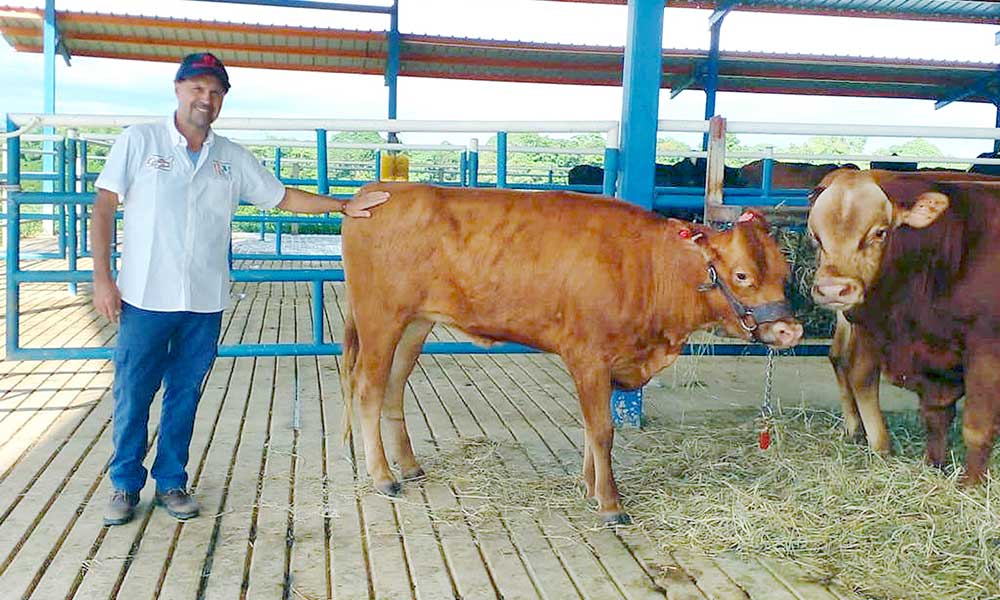The Dominican Republic continues to add new breeds to the improvement and strengthening of livestock genetics, and little by little it has been placing itself in an important position in this matter.
It has been betting, for example, on dual-purpose livestock (meat and milk) and according to the results obtained, as well as the opinions of specialists on the subject, it is on the right track.
Crosses have been made and the specimens that are regularly observed on both sides of the country, keep a long distance from the cattle that were had in the past.
The dairy breed that the Dominican Republic had before was essentially of European origin (Holstein, Pardo Suizo and Jersey), but more or less recent data indicate that – possibly – the properties or farms with pure Brown Swiss do not currently exceed five, while, with There are two pure holstein farms and there are two of pure jersey, according to a numerical cut ten months ago between producers and experts on the subject. In other words, there are less than ten farms of pure animals of those breeds.
The meat and dairy genetics of international cattle imported by the livestock sector have benefited the country, pimps and mothers of fine lineage.
For example, Ángel de la Madrid, a cattle producer from Rancho de España, recently introduced four specimens (two stallions and two mother calves) of the Wagyu breed, native to Japan, to the Dominican Republic to cross with the Senepol breed.
Of this Japanese breed, the farmer highlights two types: Wagyu Tajima Black and Wagyu Acausi red, although, according to the literature reviewed on the subject, others can be highlighted.
And he adds: “We decided to bring the red Acausi, as it is an animal that adapts easier to the tropical environment, as it grows in a subtropical area of Japan.”
The red Wagyu introduced to Rancho España comes from the Health Brand farm in Austin, Texas, United States.
De la Madrid explains that the two pimps are to father and extract semen, and the females to extract embryos. The idea is to increase the breed in the Dominican Republic.
You will cross the Red Wagyu Acausi pipts with the Senepol breed, because, from his point of view, it is a breed that tolerates heat and resists insects and livestock diseases.
Ángel de la Madrid explains that this crossing will make it possible to obtain an animal with much higher quality and better livestock production.
However, he maintains that Rancho de España aims to create a tropical Wagyu breed, as well as sell pots to other national producers.
Wagyu meat is highly appreciated for its flavor, tenderness and juiciness, being used for the preparation of high-cost gourmet dishes.
Other types of breeds have been introduced to the Dominican Republic, such as dual-purpose breeds that have raised the bar for local livestock.
Some connoisseurs of the subject have even raised at different times that “it is very likely that the future cattle ranching of the Dominican Republic will depend to a great extent on breeds such as the Gyr and the Girolando, cows that are dairy, while the males can contribute to the generation of meat”.
These specialists have been involved in the breeding and multiplication of diverse breeds for decades. The cattle ranching specializes in meat in the country is little and most of the meat that is produced comes from dairy farms, which are milked and raised by the males. This is what has historically happened. But that keeps changing, as the “dual purpose” progresses.
It has been suggested that the Dominican Republic has more farms raising pure dairy Gyr than Holstein, which is highly positive. A Gyr cow can give between ten and 15 liters of milk.
In the Dominican territory of the farms that are crossing Gyr with the native herd there were possibly more than a thousand.
From there and from other variables, for example, the farmer Pablo Contreras has started to conclude that in a short time the cattle that will be produced in the country will come from cattle crossed with Gyr or Guzerat Lechero.
About a hundred Gyr breed bulls were introduced to the country years ago. The information supplied to the Caribbean indicates that although these animals were brought from Mexico, their origin was Brazilian, taking into account that several Mexican breeders at the beginning of the 2000s acquired embryos from Brazil and that made it possible for the Aztec nation to have this breed.
Positive results of a directed process
In livestock matters, according to opinions obtained from farmers and veterinarians, among the most important animals introduced to the country in recent years, it is necessary to include in the mention the Gyr Lechera, the Guzerat Lechero and the AFS (Australian Freisian Sahiwal).
With them, a reproduction process has been directed that has resulted in positive results and a greater milk production.
Crossings have been made with these animals, and a part of those crosses have become pure animals, in relation to pure animals.
In addition, introduced and specialized breeds have been crossed with other animals, both dairy mongrels or dual-purpose animals, as well as pure or highly mixed animals. From these works, a significant number of pure animals and others of miscegenation have been obtained. In the Dominican Republic there are also constant imports of embryos from Brazil and Gyr and Girolando semen are constantly brought in. These breeds are playing a very important role in the production of milk in the country. The bulls that were brought were disseminated to all regions of the national geography and embryos have continued to be disseminated and imported, which have brought both public institutions and private farmers.


















